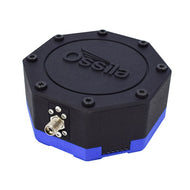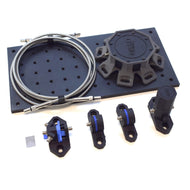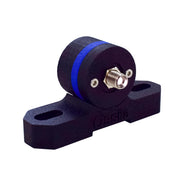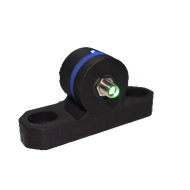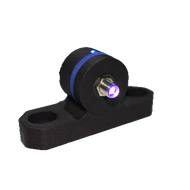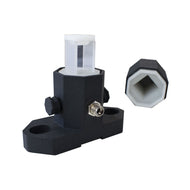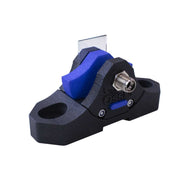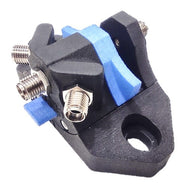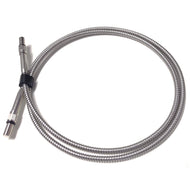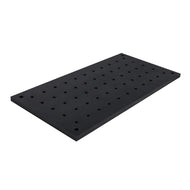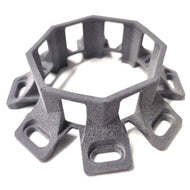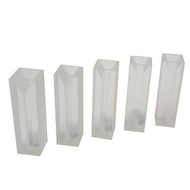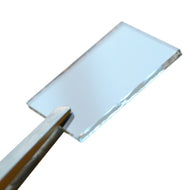Exciplex and Excimer Absorption and Emission
An exciplex (or excited complex) is a complex formed between two different conjugated molecules (monomers) when one of which is in an excited state. This short-lived complex will occur when the monomers are in close proximity to one another, and it results in a lower energy than if the two existed separately. What makes exciplexes unique is that the two monomers would not form a complex if both were in the ground state. They can therefore only form if the monomers interact before the excited one has time to relax. If the two monomers are of the same species, the complex is instead called an excimer (excited dimer).
Exciplexes are useful as TADF materials due to their small triplet-singlet energy difference. Electrons in the triplet state can therefore be thermally transferred to the singlet state from which they can fluoresce. This makes them promising for use in high efficiency third-generation OLEDs. Additionally, exciplexes are commonly used in phosphorescent (second-generation) OLEDs and also have potential as emitters in white light OLEDs. Research is ongoing into how these materials can improve device efficiencies and lifetimes, particularly for blue OLEDs.
Theory
When one molecule is in an excited state, it is possible for two conjugated molecules (monomers) in close proximity to form an excited dimer complex. When the two monomers are the same species, the complex is called an excimer (excited dimer); when they are different, the complex is known as an exciplex (excited complex).
This process can be described by:

Here, A and B are monomers and * denotes an excited state. In the case of an excimer, A=B, whereas for an exciplex, A≠B.
When both monomers are in the ground state, electronic interactions between them are not possible as all orbitals are completely full. Therefore, the monomers are repulsive due to Coulomb interactions. However, when one of them is in the excited state, interactions with the orbitals of the ground state monomer stabilise the excited state monomer, leading to a lower energy state as well as an attraction between the molecules. This is usually facilitated by π-π stacking, the mutual attraction between aromatic rings.
As the excimer/exciplex is of a lower energy than the monomer, when it relaxes back to the ground state, the photon emitted is of lower energy then the emission of the monomer. Hence, it is redshifted. In addition to this redshift, the excimer/exciplex emission is also broad and featureless (no transitions to vibrational states). This is because the exciplex ground state is very unstable and the two ground state monomers are repulsive, giving a continuum of emission energies. The diagram below illustrates how the energy of the system varies with the separation of the monomers A and B.

In the above diagram, you can see that when the separation between A and B* is sufficiently small, the total energy of the system is lower. Any emission from this state will therefore be redshifted compared to the monomer emission. In addition to this, the emission is broader due to the unstable nature (no energy well) of the ground-state excimer, and featureless due to the lack of excimer vibrational states.
Excimer/exciplex formation depends heavily on the density of the molecules. If the density is too low, the excited state will relax back down to its ground state before encountering another monomer. Therefore, exciplex emission will increase as the density is increased and emission from the monomer will be reduced. Excimers/exciplexes are generally formed in solutions due to the high likelihood of collisions between monomers. Although collisions are not possible in the solid state, in the crystalline form stacking can occur. This leads to excimers when one molecule is excited. Similarly, in amorphous solids, molecules that are in close proximity to one another can result in excimers.
Exciplexes as Emitting Materials in OLEDs
As emitters in colour OLEDs, exciplexes generally do not tend to be as efficient as the high-efficiency emitters already in use due to high non-radiative rates. However, lots of exciplexes have a very small singlet-triplet excited state energy gap, ΔST, an essential property for thermally-activated delayed fluorescence (TADF). In TADF emitters, ΔST is limited by the electron exchange energy: if this is large, so is ΔST. In exciplexes, however, the exchange energy is much smaller as the electron and hole are located on different molecules. ΔST is therefore much smaller than in standard TADF emitters. Resultingly, reverse intersystem crossing (reverse ISC) in which an excited triplet electron can be transferred to the excited singlet state through thermal energy (provided it exceeds ΔST) becomes highly likely. TADF exciplexes, therefore, are highly fluorescent and can have theoretical efficiencies of up to 100%.
Due to this broad spectrum, excimers and exciplexes are also promising as emitters in broadband OLEDs and white OLEDs (WOLEDs). For example, if the monomer chosen emits in the blue and has a broad excimer emission in the red and green, a white OLED can be produced with relative ease. This is advantageous as one layer can be used to generate all required colours. It is difficult, however, to exactly tailor the emission spectrum as it is highly-sensitive to the density of the monomers, their relative abundance, and their emission spectra.
Exciplexes as Host Materials in OLEDs
Exciplexes are also highly promising as host materials in phosphorescent (2nd generation) OLEDs. The function of host materials is to disperse the emitting material in order to reduce density-dependent emission quenching (a form of fluorescence quenching). Because exciplexes consist of two different monomers, there is an asymmetric charge density in the system and therefore charge transfer can occur between the molecules. This leads to one molecule acting as a donor and one as an acceptor. Exciplex-forming co-hosts are therefore useful for balancing charge mobilities. Furthermore, with their low driving voltages, higher external quantum efficiency (EQE), and long device lifetimes, they have been found to be an improvement on previous host materials.
Usually in an exciplex co-host, one material is p-type (hole transport) and the other is n-type (electron transport). This allows for a better carrier injection and transport compared to single host devices and will also result in higher efficiencies. As the electrons and holes are able to recombine over the whole emitter layer, the exciton density is lower and less localised, thus, triplet-triplet annihilation is reduced. Additionally, the lifetimes of OLEDs that use exciplex co-hosts are improved because of the separate electron and hole transport materials. In single hosts, the transport of both types of carrier will lead to degradation and reduced lifetimes.
Exciplex co-hosts are now the host of choice for red and green phosphorescent OLEDs; however, blue LEDs still remain problematic due to the high triplet energies required to facilitate energy transfer. This is because Intersystem Crossing (ISC) is more likely to occur if the singlet and triplet states are at similar energies. The hunt for blue OLED materials is therefore ongoing.
Related Products
